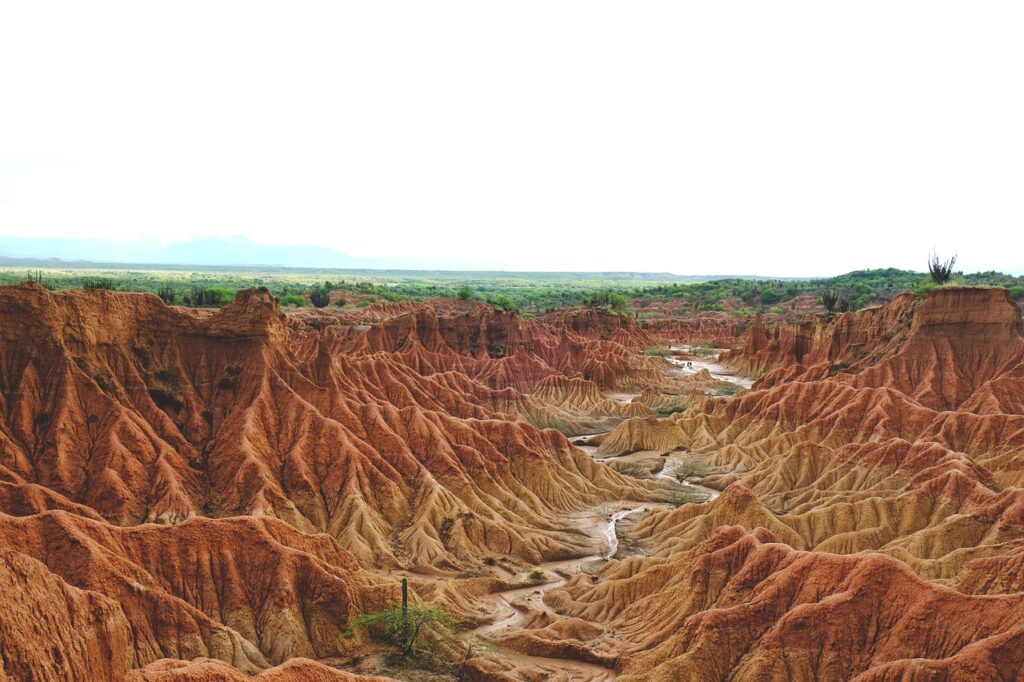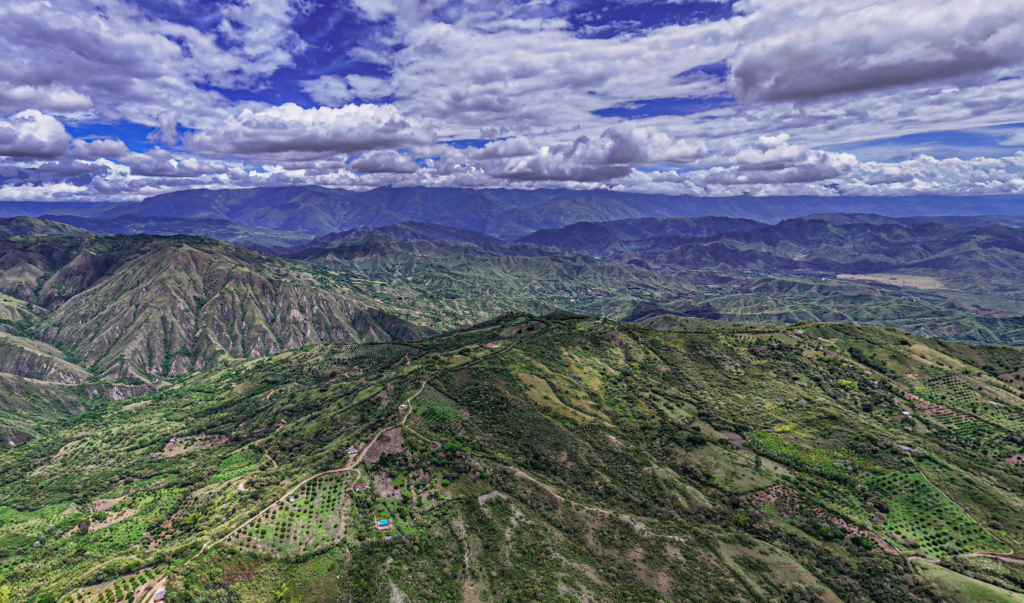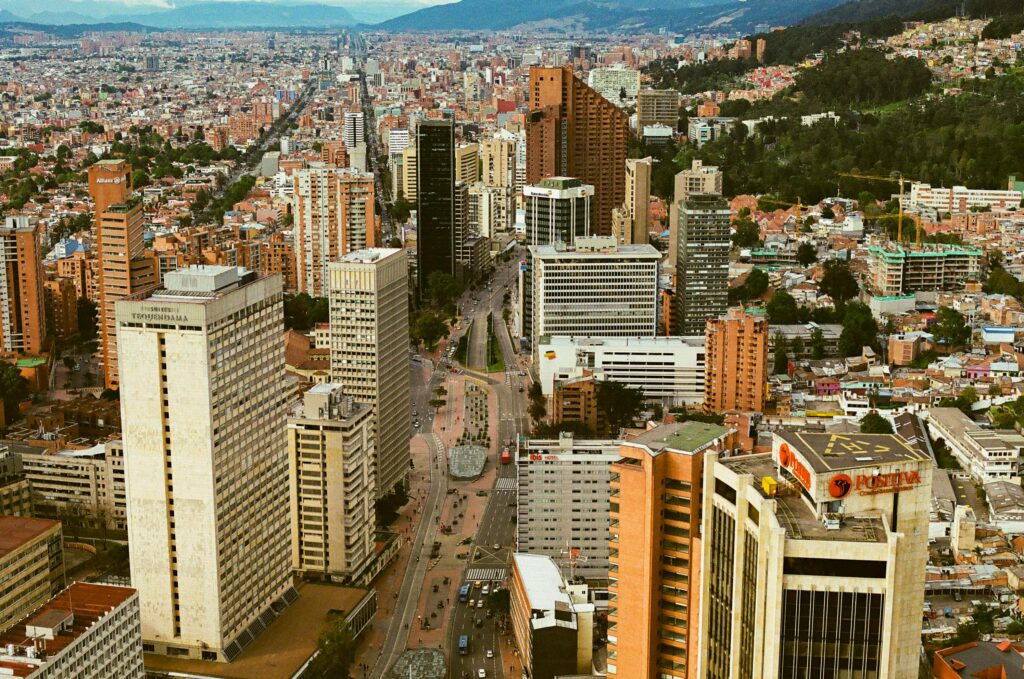Colombia / República de Colombia – Let’s explore here
What’s in like in Colombia?
Colombia is a large country in South America, almost five times the size of the United Kingdom. It’s population is around 49 million people (2023) and its capital, Bogotá, is home to almost 13 million.
To the west lie the Andes mountains and the Pacific coast. Moving south from the Caribbean coast in the north, the land becomes savannah and then jungle as it enters the Amazon rain forest. Also in the north of the country lie the Sierra Nevada de Santa Marta, a mountain range separate from the Andes range. Within the range are the Pico Cristóbal Colón and the Pico Simón Bolívar, both of which are almost 19,000ft (5,775 m) above sea level, and only 42 km (26 mi) from the Caribbean coast. The Sierra Nevada is the highest coastal range in the tropics, and one of the highest coastal ranges in the world.

A bit about the history of Colombia
Colombia’s history is shaped by Indigenous cultures, Spanish colonisation, struggles for independence, periods of violence, and its transformation into a modern republic.
Spanish colonisation
Before Spanish arrival, Colombia was inhabited by several Indigenous groups, such as the Muisca, Tairona, and Quimbaya, with advanced societies and complex political structures. In 1499, Spanish explorers, led by Rodrigo de Bastidas, arrived on the Caribbean coast, and soon after, Spain began colonising the region. Colombia became part of the Spanish Viceroyalty of Peru, and later the Viceroyalty of the Río de la Plata.
Struggle for independence
The struggle for independence from Spain began in the early 19th century, fueled by the ideals of the American and French Revolutions. Colombia’s independence movement was led by figures such as Simón Bolívar, who liberated much of northern South America. Colombia, along with Venezuela, Ecuador, and Panama, formed Gran Colombia in 1819, a short-lived republic that dissolved by 1831, after which Colombia became a separate republic.
War
Throughout the 19th and early 20th centuries, Colombia experienced periods of political instability, including civil wars between the Liberal and Conservative parties. One of the most significant conflicts was the Thousand Days’ War (1899–1902), which devastated the country and resulted in the loss of Panama, which gained independence with US support and became a separate nation in 1903.
Cartels
In the 20th century, Colombia experienced political violence, especially during the period known as “La Violencia” (1948–1958), which was marked by intense fighting between Liberals and Conservatives. Afterward, a period of National Front government (1958–1974) aimed at stabilising the country, with power shared between the two parties. However, the rise of left-wing guerrilla movements, such as the Revolutionary Armed Forces of Colombia (FARC), and drug cartels, particularly the Medellín and Cali cartels, led to violent conflicts and social unrest in the late 20th century.
From the 1980s to the early 2000s, Colombia faced severe violence from drug traffickers, guerrilla warfare, and paramilitary groups. The government, with US assistance, fought against these groups, but the country was plagued by human rights abuses and instability.
Democracy and economic growth
In recent decades, Colombia has made significant progress in reducing violence, improving security, and strengthening its economy. Today, Colombia is a democratic republic, known for its rich cultural heritage, coffee production, and diverse landscapes. Despite challenges like inequality and the residual effects of internal conflict, Colombia has emerged as one of the most dynamic economies in Latin America. It is also recognised for its vibrant arts scene, including music genres like cumbia and salsa, as well as its growing tourism industry.


Colombia road trip
Our Colombian road trip is part of a much larger South American road trip.
Map of our road trip through Colombia

Our current planned road trip in Colombia takes us from Panama via the sea into the north of the country, and then southwards towards Ecuador.
No doubt this Pan-South American route will change once we reach Colombia, so that we can explore the country in more depth.
Hopefully our journey will improve our knowledge of this intriguing and beautiful country, and enable us to meet some interesting people. We’ll be updating this page at that time – don’t forget to check back
What’s it like to drive in Colombia?
They drive on the right hand side of the road in Colombia. Main roads are quite good in Colombia, however rural roads are poor, as are driving standards.
Do you require an international driving permit in Colombia?
We’ve created a dedicated page to driving abroad, which answers this question, and more, which you might find helpful.
Can you use your UK driving license when driving through Colombia?
We’ve created a dedicated page to driving abroad, which answers this question, and more, which you might find helpful.
Do I need a carnet de passages to drive in Colombia?
We’ve created a dedicated page to driving abroad, which answers this question, and more, which you might find helpful.
What currency do they use in Colombia?
In Colombia they use the Colombian Peso. Cash is widely used. The use of credit / debit cards is widely accepted in major cities, although not in rural areas. Travellers cheques are accepted in major cities only. There are many ATMs in cities, although not all accept foreign issued cards.
All foreign tourists are entitled to VAT refunds on products purchased – apply at the offices of the DIAN (National Tax and Customs Department), located in the international sea, land and air ports, or at the Special Border Development Unit checkpoint.
You should make yourself aware of the amount that your bank charges you for using credit and debit cards abroad. Often credit cards are cheaper for purchasing items directly, and for withdrawing cash from ATMs.
What language do they speak in Colombia?
They speak Colombian Spanish in Colombia. English is spoken widely in Providencia and Santa Catalina, but elsewhere is not spoken outside of major cities.
What time zone is Colombia in?
Remember, when you’re planning your next trip to take a look at what time zone it’s in.
Do I need a visa to visit Colombia?
We’ve created a dedicated, more comprehensive page on visas, which you should find helpful. Check it out!
Is wild camping legal in Colombia?
Yes, wild camping is fine in Colombia, although make sure the land is not private or used for cultivation of drugs.
What plug / socket type do they use in Colombia?
In Colombia they use plug / socket types A and B.


Health issues in Colombia
Is it safe to drink water in Colombia?
Yes, it is safe to drink water in major cities, however in more rural areas it is not safe to drink the water.
What vaccinations are required for Colombia?
This NHS website is kept up to date with all relevant information on vaccinations in Colombia.
Phones in Colombia
What is the country calling code for Colombia?
The country calling code for Colombia is +57
What are the emergency phone numbers in Colombia?
- The emergency number for police in Colombia is: 112
- In Colombia, the emergency number for ambulance is: 125
- The emergency number for fire in Colombia is: 119
If you’ve got some useful info that you’d like to share, let us know!
And don’t forget to check out all the other pictures!
